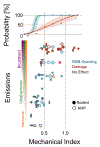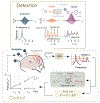Towards controlled drug delivery in brain tumors with microbubble-enhanced focused ultrasound
- PMID: 34801617
- PMCID: PMC8724442
- DOI: 10.1016/j.addr.2021.114043
Towards controlled drug delivery in brain tumors with microbubble-enhanced focused ultrasound
Abstract
Brain tumors are particularly challenging malignancies, due to their location in a structurally and functionally distinct part of the human body - the central nervous system (CNS). The CNS is separated and protected by a unique system of brain and blood vessel cells which together prevent most bloodborne therapeutics from entering the brain tumor microenvironment (TME). Recently, great strides have been made through microbubble (MB) ultrasound contrast agents in conjunction with ultrasound energy to locally increase the permeability of brain vessels and modulate the brain TME. As we elaborate in this review, this physical method can effectively deliver a wide range of anticancer agents, including chemotherapeutics, antibodies, and nanoparticle drug conjugates across a range of preclinical brain tumors, including high grade glioma (glioblastoma), diffuse intrinsic pontine gliomas, and brain metastasis. Moreover, recent evidence suggests that this technology can promote the effective delivery of novel immunotherapeutic agents, including immune check-point inhibitors and chimeric antigen receptor T cells, among others. With early clinical studies demonstrating safety, and several Phase I/II trials testing the preclinical findings underway, this technology is making firm steps towards shaping the future treatments of primary and metastatic brain cancer. By elaborating on its key components, including ultrasound systems and MB technology, along with methods for closed-loop spatial and temporal control of MB activity, we highlight how this technology can be tuned to enable new, personalized treatment strategies for primary brain malignancies and brain metastases.
Keywords: Blood brain barrier; Blood tumor barrier; Brain cancer; Drug delivery; Focused ultrasound; Micro-bubbles; Ultrasound Immunomodulation.
Copyright © 2021 Elsevier B.V. All rights reserved.
Conflict of interest statement
Declaration of Competing Interest The authors declare that they have no known competing financial interests or personal relationships that could have appeared to influence the work reported in this paper.
Figures





Similar articles
-
Enhancement in blood-tumor barrier permeability and delivery of liposomal doxorubicin using focused ultrasound and microbubbles: evaluation during tumor progression in a rat glioma model.Phys Med Biol. 2015 Mar 21;60(6):2511-27. doi: 10.1088/0031-9155/60/6/2511. Epub 2015 Mar 6. Phys Med Biol. 2015. PMID: 25746014 Free PMC article.
-
Overcoming the blood-brain tumor barrier for effective glioblastoma treatment.Drug Resist Updat. 2015 Mar;19:1-12. doi: 10.1016/j.drup.2015.02.002. Epub 2015 Mar 6. Drug Resist Updat. 2015. PMID: 25791797 Review.
-
Prolonged survival upon ultrasound-enhanced doxorubicin delivery in two syngenic glioblastoma mouse models.J Control Release. 2014 Aug 10;187:74-82. doi: 10.1016/j.jconrel.2014.05.033. Epub 2014 May 27. J Control Release. 2014. PMID: 24878186
-
Brainstem blood brain barrier disruption using focused ultrasound: A demonstration of feasibility and enhanced doxorubicin delivery.J Control Release. 2018 Jul 10;281:29-41. doi: 10.1016/j.jconrel.2018.05.005. Epub 2018 May 16. J Control Release. 2018. PMID: 29753957 Free PMC article.
-
Targeting diffuse midline gliomas: The promise of focused ultrasound-mediated blood-brain barrier opening.J Control Release. 2024 Jan;365:412-421. doi: 10.1016/j.jconrel.2023.11.037. Epub 2023 Nov 30. J Control Release. 2024. PMID: 38000663 Free PMC article. Review.
Cited by
-
Microbubble Delivery Platform for Ultrasound-Mediated Therapy in Brain Cancers.Pharmaceutics. 2023 Feb 19;15(2):698. doi: 10.3390/pharmaceutics15020698. Pharmaceutics. 2023. PMID: 36840020 Free PMC article. Review.
-
A low-complexity and high-frequency ASIC transceiver for an ultrasound imaging system.Biomed Eng Lett. 2024 Jul 25;14(6):1377-1384. doi: 10.1007/s13534-024-00411-1. eCollection 2024 Nov. Biomed Eng Lett. 2024. PMID: 39465100 Free PMC article.
-
Targeted Microbubbles for Drug, Gene, and Cell Delivery in Therapy and Immunotherapy.Pharmaceutics. 2023 May 30;15(6):1625. doi: 10.3390/pharmaceutics15061625. Pharmaceutics. 2023. PMID: 37376072 Free PMC article. Review.
-
Could encapsulation of natural compounds in BBB-permeable nanocarriers produce effective Alzheimer's disease treatments?Nanomedicine (Lond). 2025 Mar;20(5):435-438. doi: 10.1080/17435889.2024.2444859. Epub 2024 Dec 27. Nanomedicine (Lond). 2025. PMID: 39727082 No abstract available.
-
Focused Delivery of Chemotherapy to Augment Surgical Management of Brain Tumors.Curr Oncol. 2022 Nov 17;29(11):8846-8861. doi: 10.3390/curroncol29110696. Curr Oncol. 2022. PMID: 36421349 Free PMC article. Review.
References
Publication types
MeSH terms
Substances
Grants and funding
LinkOut - more resources
Full Text Sources
Medical
Research Materials
Miscellaneous

